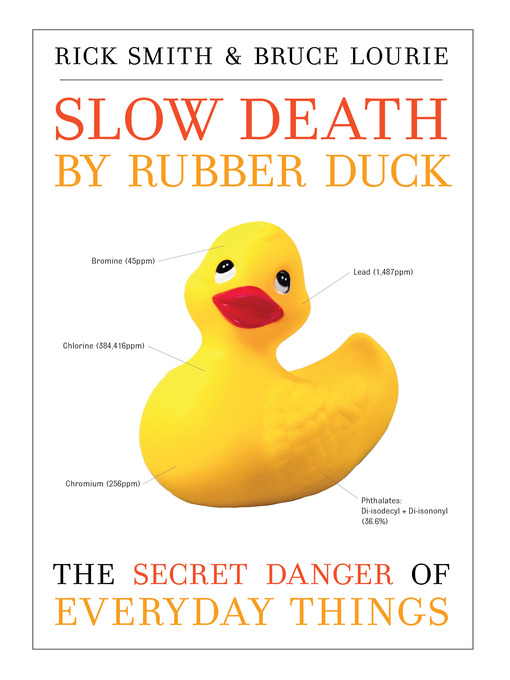- All Magazines
- Popular Magazines: Always Available
- Cooking and Food Magazines
- Craft Magazines
- News and Politics
- See all magazines collections
Pollution is no longer just about belching smokestacks and ugly sewer pipes—now, it’s personal.
The most dangerous pollution, it turns out, comes from commonplace items in our homes and workplaces. To prove this point, for one week Rick Smith and Bruce Lourie ingested and inhaled a host of things that surround all of us. Using their own bodies as the reference point to tell the story of pollution in our modern world, they expose the corporate giants who manufacture the toxins, the government officials who let it happen, and the effects on people and families across the globe.
This book—the testimony of their experience—also exposes the extent to which we are poisoned every day of our lives, from the simple household dust that is polluting our blood to the toxins in our urine that are created by run–of–the–mill shampoos and toothpaste. Ultimately hopeful, the book empowers readers with some simple ideas for protecting themselves and their families, and changing things for the better.
-
Creators
-
Publisher
-
Release date
December 10, 2009 -
Formats
-
Kindle Book
-
OverDrive Read
- ISBN: 9781582436760
-
EPUB ebook
- ISBN: 9781582436760
- File size: 1334 KB
-
-
Languages
- English
-
Reviews
-
Publisher's Weekly
Starred review from January 4, 2009
Undertaking a cheeky experiment in self-contamination, professional Canadian environmentalists Smith and Lourie expose themselves to hazardous everyday substances, then measure the consequences. Inspired by data from the Environmental Working Group that shows Americans carry significant amounts of toxic industrial chemicals in our bodies (and published research tying those toxins to obesity, ADHD, autism, Alzheimer's, heart disease, and diabetes), Smith and Lowrie attempt to increase their personal "body load" of seven particularly worrisome toxins-phthalates, Teflon, ubiquitous anti-bacterial triclosan, brominated fire retardants, Bisphenol A, mercury, and hormone-based pesticide 2.4-D-through everyday North American activity: eating, drinking, sleeping, cleaning, watching TV, etc. Smith and Lowrie describe in detail the reasons behind and parameters of their self-experiment, including the hows and whys of blood and urine testing, and the specific products (Coke, Stainmaster carpet cleaner, Rubbermaid microwavable containers) purchased to increase their exposures. They also discuss their attempts to flush and avoid toxins before the experiment (Smith tries eating only food that hasn't come into contact with plastics, which proves impossible). Throughout, the duo weave scientific data and recent political history into an amusing but unnerving narrative, refusing to sugarcoat any of the data (though protection is possible, exposure is inevitable) while maintaining a welcome sense of humor. -
Booklist
Starred review from January 1, 2010
This is one scary book. Using a variety of test methods, the authors determined individual body burdens, or the toxic chemical load we carry. The innocuous rubber duck, for example, offers a poison soup of phthalates that permeate the environment and humans. From other products and food, we also have a collection of chemicals shorthanded as PFCs, PFOAs, PSOSs, and PCBs. None of them are good, and they are everywhere, thanks to Teflon (which drew the largest administrative penalty against a company ever obtained by the EPA), Stainmaster, nonflammable pajamas, tuna (hello, mercury), and, would you believe, antibacterial products. The legacy of our chemically addicted society is not just all around us but also inside us, and it is killing us, as the Teflon case proved. (Workers in West Virginia believed that having a high-paying job often meant getting sick, and many were reluctant to sue and possibly scare DuPont away.) Poised between chirpy green-living manuals and dense academic papers, Smith and Bruce Lourie have crafted a true guide for the thinking consumer. If readers dont change their ways after reading this one, then they never will.(Reprinted with permission of Booklist, copyright 2010, American Library Association.)
-
Formats
- Kindle Book
- OverDrive Read
- EPUB ebook
subjects
Languages
- English
Loading
Why is availability limited?
×Availability can change throughout the month based on the library's budget. You can still place a hold on the title, and your hold will be automatically filled as soon as the title is available again.
The Kindle Book format for this title is not supported on:
×Read-along ebook
×The OverDrive Read format of this ebook has professional narration that plays while you read in your browser. Learn more here.


